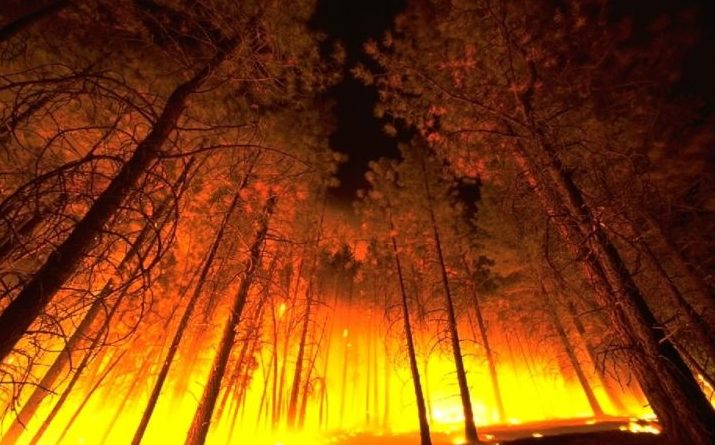Adding Fuel to the Fire: Climate change is exacerbating western wildfires
Article by Hannah Klaus
In 2015, more than 10 million acres of forests burned in the U.S. So far this year, almost 5 million acres have burned. A study on U.S. forest activity published earlier this found that, from 2003 to 2012, the average area burned annually in Western National forests was 1,271 percent greater than in the 1970s and 1980s (2,6).
Some wildfires occur naturally and have an important role in nature. As plants burns and decompose, they return nutrients to the soil for new plant growth. When larger, sun-blocking trees are cleared in a fire, there is then an opportunity for sunlight to reach lower levels within the forest. Wildfires also cleanse forest ecosystems of disease and harmful pests (4). However, with the amount of acres burned by wildfires in recent years, we are seeing too much of a good thing.
So what is fueling the fire? According to a study from the National Proceeding of the National Academies of Science conducted by John T. Abatzoglou and A. Park Williams, global climate change is responsible for almost doubling the area burned by forest fires in the Western U.S. between 1984 and 2015. The researchers attribute this increase in burning record heat and dry climate in the past few decades (1).
“A lot of people are throwing around the words climate change and fire—specifically, last year fire chiefs and the governor of California started calling this the ‘new normal,’ ” said lead author John Abatzoglou, a professor of geography at the University of Idaho. “We wanted to put some numbers on it.” (3).
Fuel, oxygen, and a heat source are the three required components for a wildfire. Dry weather increases fuel sources by providing more dried vegetation to burn. Warm weather aids in the combustion of wildfires and strong winds spread the flames. Wildfires are most frequent in the U.S. in western states where warm temperatures, drought, and frequent thunderstorms create ideal conditions (4). Per Abatzoglou and Williams, average temperatures in the Western U.S. have increased by 2.5 degrees Fahrenheit since 1970, which is greater than warming anywhere else on Earth (1). Warmer, drier conditions are making wildfires significantly worse than they used to be. As found the two researchers, there is a correlation between this change in climate and an increase in wildlife intensity and duration (1). They concluded that fuels for wildfires will eventually become a limiting factor if burned forest become so patchy that they can no longer burn (1) At the same time, however, plants and trees killed off by fires dry and can become fuel for wildfires (5).
Although little can be done to prevent the current rises in temperature, certain land management strategies can help to ensure that wildfires have a healthy burning. Wildfires must be allowed to burn over specified periods in order to prevent forests from becoming overstock with trees. If forests become too dense, with many dead, dried trees still standing, when a fire does occur it will be much more intense. However, land managers have often been mislead and encouraged to make even effort to suppress wildfires (3).
In order to preserve diverse and healthy forests in the Western U.S., we must continue to take national and international action to address climate change by reducing greenhouse gas emissions. Additionally, wildfires must be handled with proper land management strategies.
- Abatzoglou, John T., and A. Park Williams. “Impact of Anthropogenic Climate Change on Wildfire across Western US Forests.” Proceedings of the National Academy of Sciences of the United States of America PNAS, Proceedings of the National Academy of Sciences, October 10, 2016. Accessed October 25, 2016. http://www.pnas.org/content/113/42/11770.abstract?tab=author-info.
- Carswell, Cally. “The West Is Burning, And Climate Change Is Partly To Blame.” FiveThirtyEight. October 18, 2016. Accessed October 25, 2016. http://fivethirtyeight.com/features/the-west-is-burning-and-climate-change-is-partly-to-blame/.
- “Climate Change Has Doubled Western US Forest Fires.” Climate Change Has Doubled Western US Forest Fires. October 10, 2016. Accessed October 25, 2016. http://phys.org/news/2016-10-climate-western-forest.html.
- “Wildfires Article, Forest Fires Information, Wildland Fires Facts — National Geographic – Test.” National Geographic. Accessed October 25, 2016. http://environment.nationalgeographic.com/environment/natural-disasters/wildfires/.
- Worland, Justin. “Climate Change Doubled the Size of Forest Fires in Western U.S., Study Says.” Time. October 10, 2016. Accessed October 25, 2016. http://time.com/4525178/climate-change-forest-fires/.
- Wrestling, Anthony LeRoy. “Increasing Western US Forest Wildfire Activity: Sensitivity to Changes in the Timing of Spring.” Philosophical Transactions B, March 23, 2016. Accessed October 25, 2016. http://ulmo.ucmerced.edu/pdffiles/16RSTB_Westerling.pdf.

